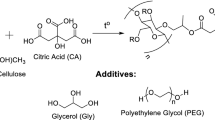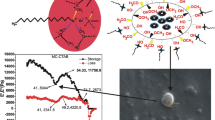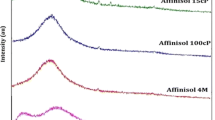Abstract
This work focuses on the study of rheological and gel properties of hydroxypropyl methylcellulose (HPMC)/hydroxypropyl starch (HPS) blends. It was found that both rheological properties in solution and gel behaviors in hydrogel of the blends depended on polymer/solvent concentration, HPMC/HPS ratio, and temperature. At higher temperature, all the blending samples showed hydrogel behavior, while at lower temperature, the suspensions with higher HPS ratio displayed hydrogel-like behavior but the gels were able to be destroyed at higher frequencies. With an increase of the HPS ratio, the fluid behavior index deceases, meaning the solution shows more obvious pseudoplastic behavior. However, the fluid consistency index increases, meaning that viscosity increases with increase of HPS content. The strength of HPMC gel was weakened by additional of HPS at higher temperature, while the HPS gel was weakened by addition of HPMC at lower temperatures. Viscosities of both HPMC and HPS were balanced by the blending at different temperatures since one is thermal and other is cool gel, which improves the processability for many applications.





Similar content being viewed by others
References
Al-tabakha MM (2010) HPMC capsules: current status and future prospects. J Pharm Pharm Sci 13:428–442
Chiwele I, Jones BE, Podczeck F (2000) The shell dissolution of various empty hard capsules. Chem Pharm Bull 48:951–956
Cole ET, Scott RA, Cade D, Connor AL, Wilding I (2004) In vitro and in vivo pharmacoscintigraphic evaluation of ibuprofen hypromellose and gelatin capsules. Pharm Res 21:793–798
Ku MS, Li W, Dulin W, Donahue F, Cade D, Benameur H, Hutchison K (2010) Performance qualification of a new hypromellose capsule: part I. comparative evaluation of physical, mechanical and processability quality attributes of V caps plus®, Quali-V® and gelatin capsules. Int J Pharm 386:30–41
Ogura T, Yoshihiro Y, Matsuura S (1998) HPMC capsules—an alternative to gelatin. Pharm Tech Eur 10:32–42
Viriden A, Wittgren B, Andersson T, Abrahmsen-Alami S, Larsson A (2009) Influence of substitution pattern on solution behavior of hydroxypropyl methylcellulose. Biomacromolecules 10:522–529
Zhang L, Wang Y, Liu H, Zhang N, Liu X, Chen L, Yu L (2013) Development of capsules from natural plant polymers. Acta Polym Sin 1:1–10
Zhang L, Wang Y, Liu H, Yu L, Liu X, Chen L, Zhang N (2013) Developing hydroxypropyl methylcellulose/hydroxypropyl starch blends for use as capsule materials. Carbohyd Polym 98:73–79
Zhang N, Liu H, Yu L, Liu X, Zhang L, Chen L, Shanks R (2013) Developing gelatin–starch blends for use as capsule materials. Carbohyd Polym 92:455–461
Masayuki T, Katsuyoshi N (2009) Gels structures, properties and functions: fundamentals and applications. Springer, Berlin
Liu SQ, Joshi SC, Lam YC, Tam KC (2008) Thermoreversible gelation of hydroxypropylmethylcellulose in simulated body fluids. Carbohyd Polym 72:133–143
Dhillon S, Seetharaman S (2011) Rheology and texture of starch gels containing iodine. J Cereal Sci 54:374–379
Haque A, Morris ER (1993) Thermogelation of methylcellulose. Part I: molecular structures and processes. Carbohyd Polym 22:161–173
Haque A, Richardson RK, Morris ER (1993) Thermogelation of methylcellulose. 2. Effect of hydroxypropyl substitutents. Carbohyd Polym 22:175–186
Hirren M, Chevillard C, Desbrieres J, Axelo M, Rinaudo M (1998) Thermogelation of methylcellulose: new evidence for understanding the gelation mechanism. Polymer 39:6251–6259
Kato T, Yokoyama M, Takahashi A (1978) Melting temperature of thermally reversible gels. IV. Methyl cellulose-water gels. Colloid Polym Sci 256:15–21
Li L (2002) Thermal gelation of methylcellulose in water: scaling and thermoreversibility. Macromolecules 35:5990–5998
Takahashi M, Shimazaki M, Yamamoto J (2001) Thermoreversible gelation and phase separation in aqueous methyl cellulose solutions. J Appl Polym Sci B Polymer Physics 39:91–100
Viriden A, Larsson A, Schagerlof H, Wittgren B (2010) Model drug release from matrix tablets composed of HPMC with different substituent heterogeneity. Int J Pharm 401:60–67
Rosella CM, Yokoyama W, Shoemaker C (2011) Rheology of different hydrocolloids–rice starch blends: effect of successive heating–cooling cycles. Carbohyd Polym 84:373–382
Kim HS, BeMiller JN (2012) Effects of hydrocolloids on the pasting and paste properties of commercial pea starch. Carbohyd Polym 88:1164–1171
Haque A, Morris ER (1994) Combined use of ispaghula and HPMC to replace or augment gluten in breadmaking. Food Res Int 21:379–393
Correa MJ, Añón MC, Pérez GT, Ferrero C (2010) Effect of modified celluloses on dough rheology and microstructure. Food Res Int 43:780–787
Lorenzo G, Zaritzky NM, Califano AN (2009) Rheological characterization of refrigerated and frozen non-fermented gluten-free dough: effect of hydrocolloids and lipid phase. J Cereal Sci 50:255–261
Kadokawa JI, Murakami MA, Takegawa A, Kaneko Y (2009) Preparation of cellulose–starch composite gel and fibrous material from a mixture of the polysaccharides in ionic liquid. Carbohyd Polym 75:180–183
Jones BE (2004) Gelatin: manufacture and physico-chemical properties. In: Podczeck F, Jones BE (eds) Pharmaceutical capsules. Pharmaceutical Press, London, pp 23–60
Ortega-Ojeda FE, Larsson H, Eliasson AC (2004) Gel formation in mixtures of amylose and high amylopectin potato starch. Carbohyd Polym 57:55–66
Matsumoto T, Kawai M, Masudat T (1992) Viscoelastic and SAXS investigation of fractal structure near the gel point in alginate aqueous systems. Macromolecules 25:5430–5433
Silva SMC, Pinto FV, Antunes FE, Miguel MG, Sousa JJS, Pais AACC (2008) Aggregation and gelation in hydroxypropylmethyl cellulose aqueous solutions. J Colloid Interf Sci 327:333–340
Bodvik R, Dedinaite A, Karlson L, Bergstrom M, Baverback P, Pedersen JS, Edwards K, Karlsson G, Varga I, Claesson PM (2010) Aggregation and network formation of aqueous methylcellulose and hydroxypropylmethylcellulose solutions. Colloid Surface A 354:162–171
Chen HH (2007) Rheological properties of HPMC enhanced Surimi analyzed by small- and large-strain tests: I. The effect of concentration and temperature on HPMC flow properties. Food Hydrocol 21:1201–1208
Chen HH, Huang CY (2008) Rheological properties of HPMC enhanced surimi analyzed by small- and large-strain tests-II: effect of water content and ingredients. Food Hydrocol 22:313–322
Dziezak JD (1991) A focus on gums. Food Technol 45:116–132
Glicksman M (1969) Gum technology in the food industry. Academic, New York
Kulicke WM, Arendt O, Berger M (1998) Rheological characterization of the dilatant flow behavior of highly substituted hydroxypropylmethylcellulose solutions in the presence of sodium lauryl sulfate. Colloid Polym Sci 276:617–626
Narayan R, Raju KVSN (2000) The use of calcined clay as part replacement of titanium dioxide in latex paint formulations. J Appl Polym Sci 77:1029–1036
Lopes da Silva JA, Rao MA (1999) Rheological behavior of food gel system. In: Rao MA (ed) Rheology of fluid and semisolid foods. Aspen Publication, Gaithersburg, pp 219–318
Clark AH, Ross-Murphy SB (1987) Structural and mechanical properties of biopolymer gels. Adv Polym Sci 83:60
Musamp RM, Alves MM, Maia JM (2007) Phase separation, rheology and microstructure of pea protein–kappa-carrageenan mixtures. Food Hydrocol 21:92–99
Lai MF, Kuo MI, Li CF, Li CY (1996) The influence of concentration on phase transition and rheological properties of red Algal polysaccharide. Food Sci (Taiwan) 23:554-566 (in Chinese, with English abstract)
Acknowledgments
The authors from SCUT, China, would like to acknowledge the research funds NNFSC (31130042, 21174043). L. Zhang would like to knowledge the State Scholarship Fund provided by the China Scholarship Council that supports her studies in Australia.
Author information
Authors and Affiliations
Corresponding author
Rights and permissions
About this article
Cite this article
Zhang, L., Wang, Y., Yu, L. et al. Rheological and gel properties of hydroxypropyl methylcellulose/hydroxypropyl starch blends. Colloid Polym Sci 293, 229–237 (2015). https://doi.org/10.1007/s00396-014-3407-5
Received:
Revised:
Accepted:
Published:
Issue Date:
DOI: https://doi.org/10.1007/s00396-014-3407-5




